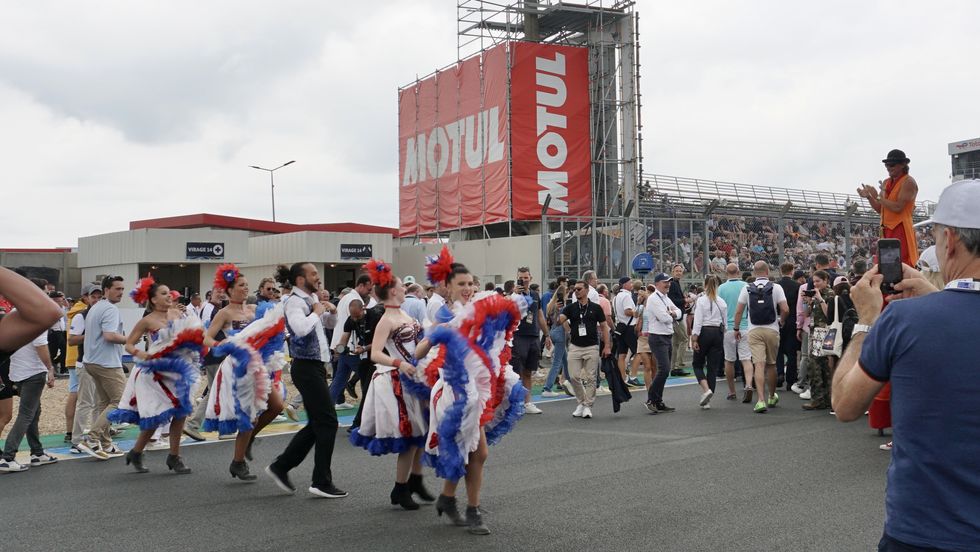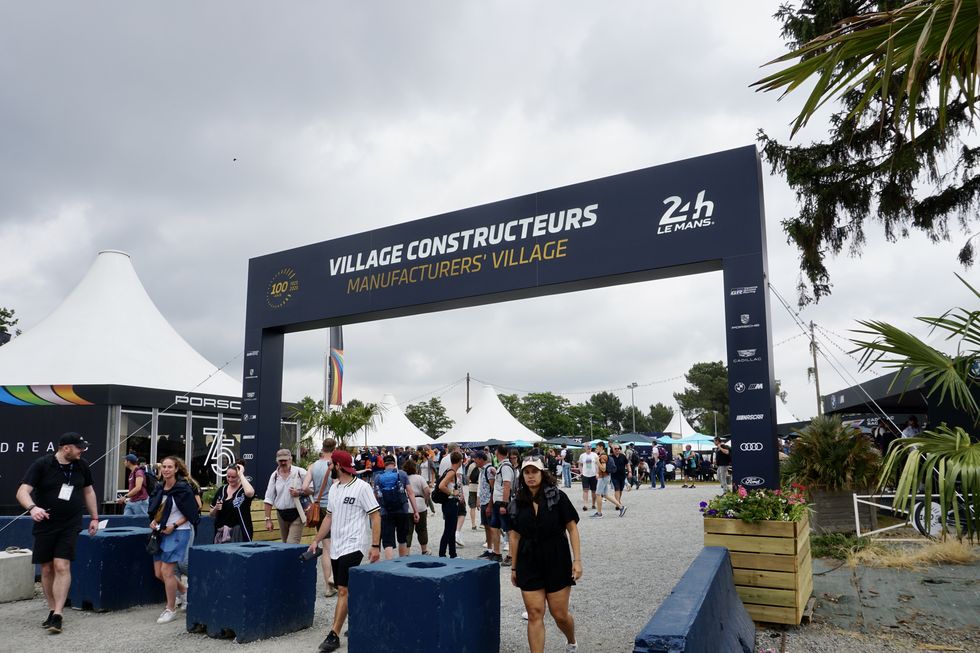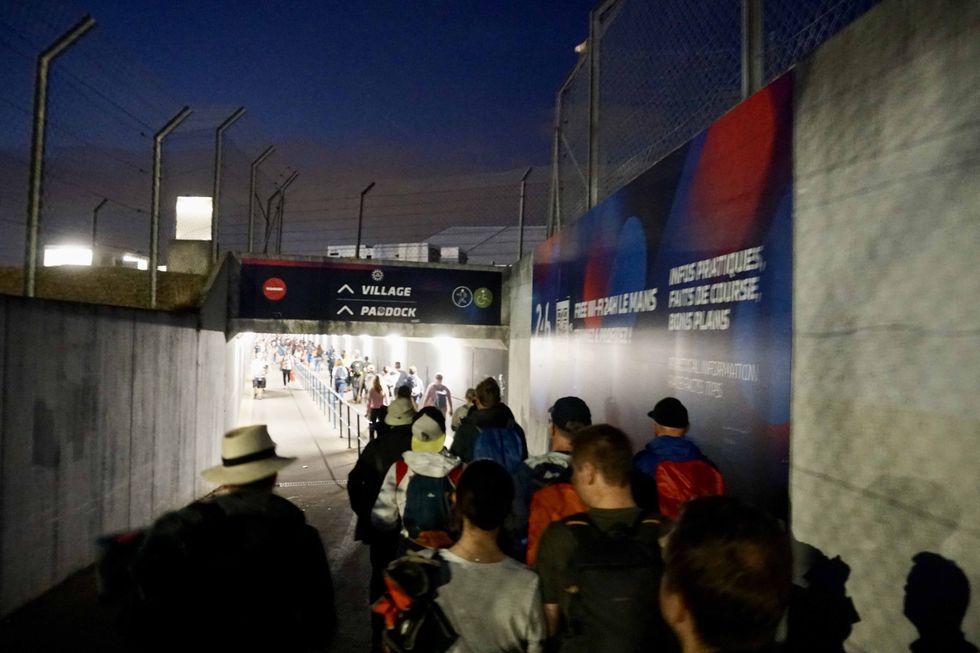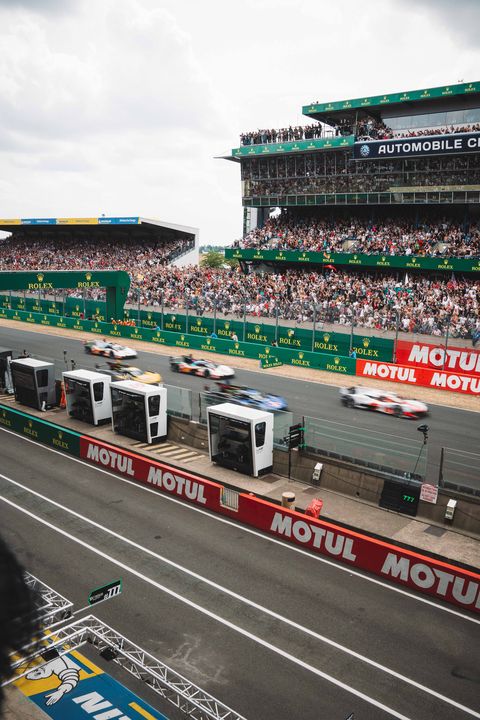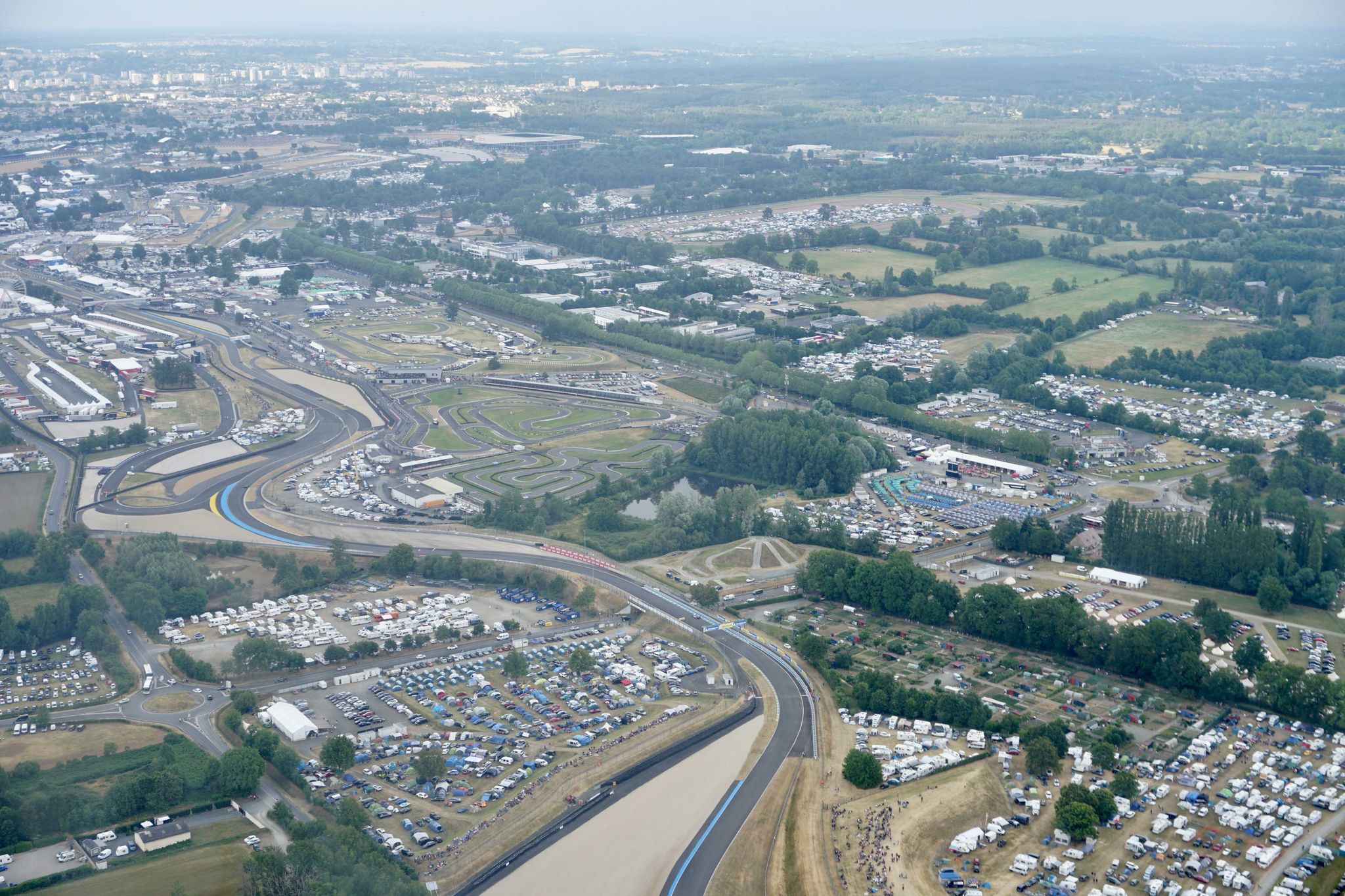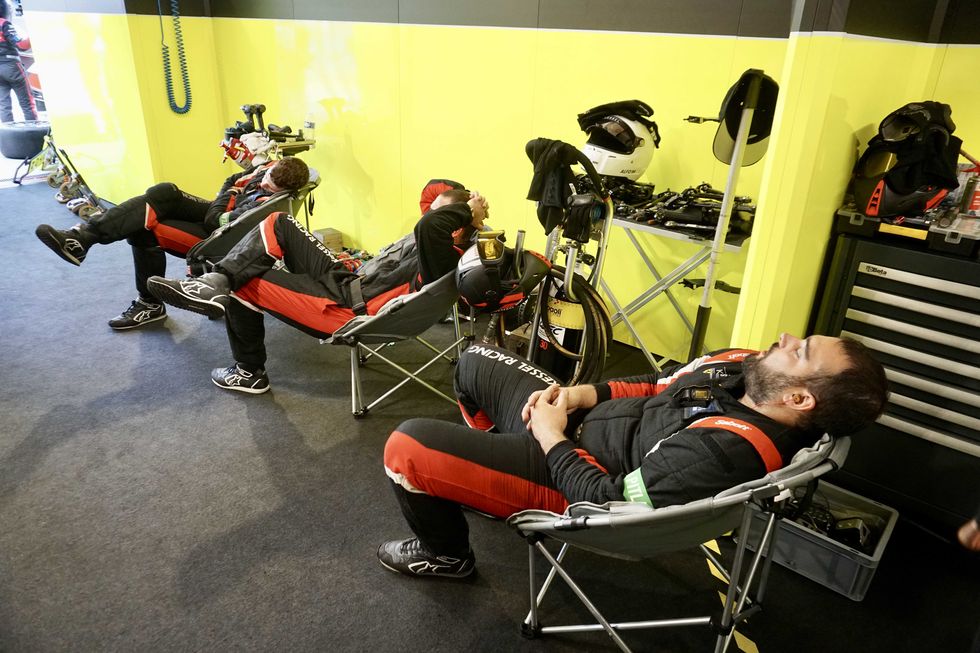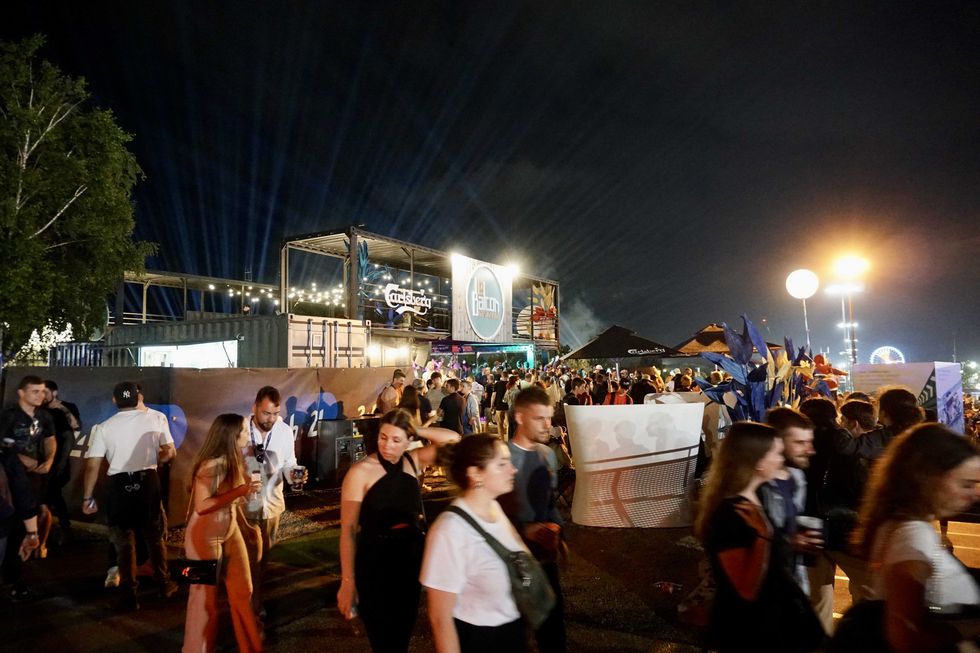It’s the day before the 24 Hours of Le Mans and we’re seated in city’s main square for the drivers’ parade, roasting under the midday June sun. Michelin is our gracious host and, being a French company and major sponsor of one of France’s largest sporting events, that means front-row bleacher seats.
Ferrari is returning to Le Mans after 50 years, a massive storyline that adds significant extra interest to this, the centenary of the first Le Mans in 1923. In dramatic fashion, Ferrari qualified in first and second on the grid, and are the first to roll out. And in true Italian style the announcers are shouting and very animated, yelling “Ferrari!” every third word while the Ferrarista cheer and wave 499P flags.
This enthusiasm never gets old.
Toyota is next up and comes out in the most Toyota fashion possible, quietly (and I’d imagine reliably) with a stock Hi-Lux and polite waves to the crowd. Having won the five previous Le Mans races, Toyota Gazoo Racing is a formidable team, and there’s great intrigue to see if Ferrari can unseat them.
They’re shooting and hurling Gazoo Racing T-shirts into the crowd. A random GR wristband lands near me, but these type of racing souvenirs seem to accumulate in boxes at home and never get pulled out. Those are best left for those who may appreciate such a thing. I’d like to get a centenary 24 Hours of Le Mans T-shirt though, I’d wear that one out.
Randomly, a lively dancing troupe from Martinique appears for some reason. There’s a lot of ceremony and pomp and you’d expect nothing less in France. Corvette also joins the parade in the most Corvette fashion, with a dramatic entrance with every generation from C1 to C8 represented, the latter ones stopping to rev their engines, much to the delight of everyone.
The Corvette Racing drivers are donning cowboy hats with red, white, and blue stripes. It’s kitschy but fun, and I like this random slice of cartoonized Americana. One of the drivers is asked how he’s finding everything, the scene feels surreal, like I’m watching something out of a narrated shaky 1950’s black-and-white newsreel. I imagine a narrator saying “the Americans have crossed the Atlantic, and what do the drivers have to say?”
Back to town square, the driver—very slowly, enunciating every word carefully, says “we-are-having-a-great-time. Thank you. Merci beaucoup.”
More teams make their rounds, Cadillac, Chevy drivers are seated in a convertible Camaro, they’ll be racing the NASCAR Garage 56 No. 24 Chevy Camaro ZL1 and are greeted with great enthusiasm, as is the French Alpine team just after them. I’ve finished two bottles of water and am a swampy mess sweating through sunscreen. A merciful cloud has long left and we’re being gently microwaved. Back to room for a rinse. This evening’s dinner is in a chateau, a bit of sustenance for what will be our own endurance race in the coming two days.
Race Morning
I wake at dawn before my all-too-early alarm, it’s race day and although I can’t even count the hours of sleep on a few fingers, this day’s early sun is bathing a building in the distance in an orange glow, and it adds a bit of magical serenity on a day that’s sure to have no shortage of action.
An early morning shuttle takes us to the Circuit de la Sarthe, the famed track whose sections and corners and straight have inspired the names of some of the greatest nameplates.
Tire Talk
The Michelin hospitality is right next to Casa Ferrari, across from Porsche, and importantly, just above the track with a terrific vantage. I get to chat with Matthieu Bonardel, Michelin’s global motorsports director, who has no shortage of insights into the race.
Every car in the Hypercar class—Ferrari, Toyota, Peugeot, Cadillac, Glickenhaus—is wearing Michelin rubber specifically designed for WEC racing, and re-formulated for this season. Bonardel says engineers are embedded with each team, working with them to understand how the cars are performing, where the stress points are on the tires based on each car’s mass distribution, powertrain and delivery, and how the compounds hold up under extreme duress and thermal extremes.
“We’re taking live data and telemetry, to help them analyze, anticipate what’s coming up, all 24 hours, both on-site and remote at other locations in France,” Bonardel says. “Drivers are hitting 330 kph (205 mph) at the end of the straight, 240 kph (149 mph) at the bridge, these cars are spending more time above 240 than below,” he says.
Drivers go about 150 miles, or a little less than an hour per, between re-fueling.
“Every time you change your tires, it’s 20 seconds,” Bonardel says. “The best team can do it in 16 seconds, and it can take up to 30 seconds. With 22-24 stops in the race, times 20 seconds, that’s around 8 minutes, and then you consider the winner is often only decided by a minute, sometimes just seconds. So tire strategy, and the importance of what your tires can do cannot be understated.
Bonardel says under dry conditions the tires are running at 120° C (248° F), really cooking. For this race Michelin has told the teams they can run three stints on these tires, and if a teams wants to push, Michelin will inspect the tires, to see if it can go another stint, which pushes the 20 second tire change on nearly an hour.
Le Mans is also special not just for the track or 24 hours, but because in the west of France in June, you often have rain showers, it often comes down hard and unexpectedly, and not necessarily on every part of the track. So there’s a strategy decision too, if there’s just a small wet area, or large wet areas, you are going to get more or less performance from your tires depending if you’re on slicks or wets.
Le Mans drivers are also pushing on the same set of tires about three times longer than the average Formula 1 tire goes. Interestingly, this year’s tires were fully developed on a simulator.
“This track is temporary, you can’t just come and rent it out and test, so there’s a lot of value being here, and getting the data to help innovate,” Bonardel adds.
The team brought a mind-boggling 8,000 tires to the race, and 3,000 will probably be used this weekend. They’re called confidentials, they don’t want anyone to have knowledge of the materials and compounding, so after the race they take them back to headquarters to dispose of them.
Road to Somewhere
After the chat, I go for a brief tunnel walk which leads you to the village or paddock, both routes absolutely filled with a sea of people. Where are they all going? I wonder as I’m drifting aimlessly about. A man is handing out flags and I take one. Once unfurled it evidently is a team Alpine flag. I shall wave it and cheer for Alpine, for their kind charity.
I pass a beer garden, and a Spanish bocadillo shop serving the classic ham sandwiches which garners dozens lining up, and the Sotheby’s auction tent, used pricey race cars lurk beyond a plastic tarp, from other eras of Motorsport.
I pass a Champagne garden, and like with the first beer garden, my ability to carry on here represents a small model of determination and what the human spirit is truly capable of. Food stands include “hommard frites,” a lobster roll and fries stand.
I pop into the “Manufacturer’s Village,” tent structures from each manufacturer have cars and various displays. Private jets fly overhead, helicopters idle, a blimp drifts, there’s almost as much action up there as down here.
I make it to the grid walk, there are cancan dancers in swoopy skirts high-kicking, general commotion, someone walking on stilts adding to the general circus atmosphere. I have to wrestle my way towards any of the cars, each swarmed with enthusiasts and fans taking photos and getting an up-close look.
On the Grid
Drivers pose for photos, the scene is building up. Michelin has a suite just above the grid which gives us a terrific vantage point for the start. Jets roar overhead with France’s own red, white, and blue contrails to great cheers.
For some reason, NBA great LeBron James is on hand to kick off the action and instructs the drivers to start their engines. The cars roar to life, pulling onto the track, swerving to warm the tires and line up in position. At 4 p.m. roars and cheer erupt in unison and within the first minute there’s chaos, crashes, and various changes of position. This first minute already has more action than the entirety of some F1 races!
Someway through the first hour I go back to a different area with a deck, people now fully into the cocktail hour, cold small mugs of beer, flutes of champagne and white wine. I rest on the railing and watch the cars blow by.
You can’t help but love the NASCAR Camaro ZL1 ripping loudly through the atmosphere, more distinct than any other car at Le Mans in any class. Somehow that raw emotion resonates. That’s what racing is really about. Countless dollars in R&D, practices, learning, development, it’s all to create something that gratifyingly connects with us somewhere deep in the skull innards.
The Friendly Skies
Next up, we’re invited to take a brief helicopter ride above the track for a different perspective, I imagine this is best to imagine with the intro music to Succession playing. I’ve had a few friends attend Le Mans through the years and this has always been a fun highlight.
Once harnessed in, the chopper ascends rapidly and we’re given a bird’s eye to the action below. It’s also neat to see the scale of the tents and camping scene, Le Mans boasts a sort of music festival vibe that happens to be at the world’s greatest endurance race. From up high the cars look like mini Hot Wheels on a kid’s toy track.
Back down below some dark clouds finally release, rain had been anticipated all afternoon and now the announcer starts screaming something on the loudspeaker with great commotion. We imagine a crash from the recent change in conditions, but who knows. Unlike some U.S. racing events, or most sports really, a lot of the time here you’re away from a good vantage point. The best coverage and understanding actually comes from the screens, mixed with a bit of onsite watching, however much you might gather.
Once, amateurishly, I wanted to stay up for nearly all of my first endurance race, the Nürburgring 24 hours, which was like 40 hours because of getting up early to drive Aston Martins, drive the parade lap, etc. After the obligatory kick-off flute of Champagne, I also had a smallish Bitburger beer every hour on the hour to show cultural respect and maintain a sort of self-appointed ambassadorial role.
Get Some Sleep
Once nighttime hit and the cars were careening through the ether as blurs of neon light, I had a new surge of energy. Sitting out on a deck trackside taking in the breeze and a steady flow of lager, very respectfully, seemed like the a terrific strategy. I was doing this right. Around 1:30 or 2am, early small hours, Aston’s CEO at the time, Andy Palmer rounded up his kids and wife and presumably went to bed.
The other holdouts made it to about 3:30 a.m. Around 4:30 I was yawning, and decided to go up to my room, but the cars were jetting by 50 yards away, and I just sort of dazed at the ceiling. It was light again, the revelry in the forest has quieted, and I had to meet everyone for breakfast and some walk-around or something at 6:30.
I imagine I looked exceptionally put-together and like a model paradigm of an endurance-race goer. It must be true. Though I admit to the untrained eye, and in fact, probably the majority of humanity, I may have looked like a frazzled, distressed raccoon. Regardless, I was wrecked for about three days straight after that.
Point being, this time I decided a few hours of sleep was a supremely excellent idea. But not before taking in a bit of the vibe. Le Balcon was the spot. DJs spinning an Aarno Remix of Douce France, the Gibson Brother’s Cuba, Madonna’s Like a Virgin, the French classic Désenchantée by Mylène Farmer garnered a sing-a-long from nearly everyone.
Party Down
It was a party, people dancing and vibing, and for a moment you might think you’re at a festival, only the occasional exhaust—probably the Camaro—ripping out in the background reminded you cars were driving nonstop high speeds and fighting for their lives and every tick of the clock.
The Peugeot 9X8 Hypercar was now first, and Porsche 2nd, Toyota has bumped to third and fourth. A German colleague and I decided we were sort of rooting for the Peugeot as well because they deliberately decided not to attach a wing because they thought it looked better without, all in the name of style.
Accidents are piling up, a handful of cars are already retired for the race. As night begins to fall, quite late now given we’re near the summer solstice, the rain has picked up in intensity, and the lights of the cars are reflecting off of the slick surface. Fireworks and a light show illuminate the sky, while headlights and taillights light the Circuit de la Sarthe.
Le Balcon is really going now and people have hoisted a child to great cheers, indeed quite a family atmosphere throughout. Outside of one of the viewing areas, people are eating midnight oysters and drinking coupes of Champagne. In the village, a full on concert is going on under the lights, people gathered around the stage, some swaying, some dancing.
Living After Midnight
Just after midnight comes word of a three car crash, including the No. 7 Toyota driven by Kamui Kobayashi. Late night drama adding to the buildup of tomorrow’s finish. We’re trying to find out if the Toyota is damaged badly or if it will be able to continue on.
With one of their two cars out, it would certainly open up the field for others. In the early morning Ferrari has taken the lead, Toyota is second with its lone car, and Cadillac is hanging in spots three and four, just waiting for any mistake from up ahead.
While it took only 30 minutes to get to the track from our hotel in town, it takes an hour and a half late night to get back. A quick shower and a blip more than three hours sleep and I’m back on a morning shuttle to the track. We hop another shuttle at the circuit, one that takes us to a different spot right up close on the Mulsanne Straight! It’s a different angle of the racing. At about 8.5 miles long, the track is more than twice as long as any of the IMSA races in the U.S., and the layout adds to its scale. To get up this close to the cars blowing by us at ferocious speeds is something that will stick.
At one point, Ferrari comes up on the now leading Toyota, having cut the gap in the previous couple of hours—and after a lengthy Toyota pit stop—the two are neck-and-neck, and ahead of a corner Ferrari makes an aggressive overtake into the lead, and as dramatic of a move as it was at the time, you didn’t get the sense that it would be the most important moment of the race. From that moment Ferrari never left the lead, and despite Toyota’s efforts to shave fractions, these positions will stand for the remaining hours.
In future Le Mans, it will not be the 100th anniversary, Ferrari may not win, Toyota may not finish second, and Cadillac may not impress in third and fourth. The raucous sentimental favorite Garage 56 Camaro ZL1 might not be in the race, Corvette may not even be in its class let alone win it, and who knows what else.
But the ceremony and pomp, the energy and grand pinnacle spirit of motorsport racing will be on display two hours west of Paris, and if you ever get the chance to attend, GO.
You won’t regret it.
Read the full article here



